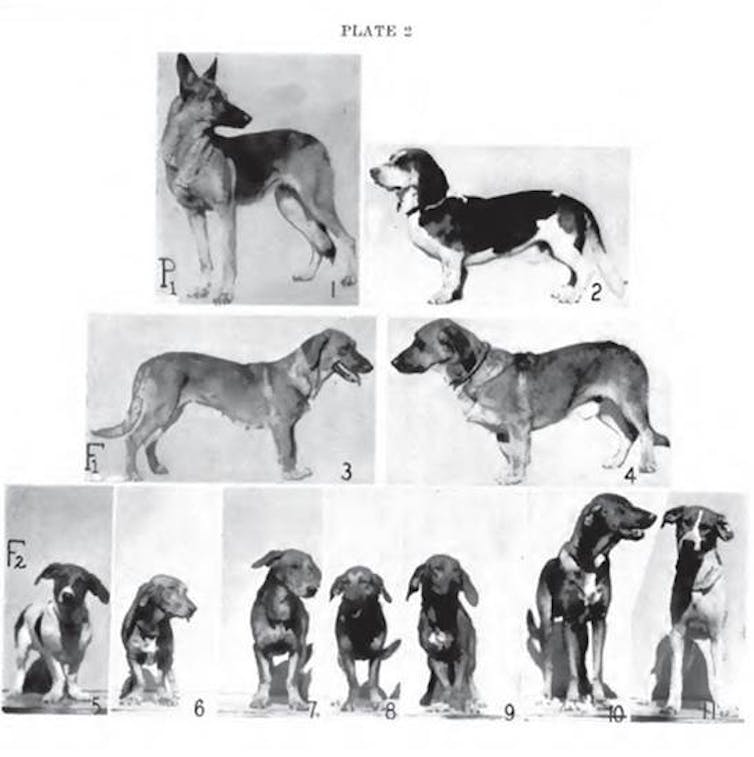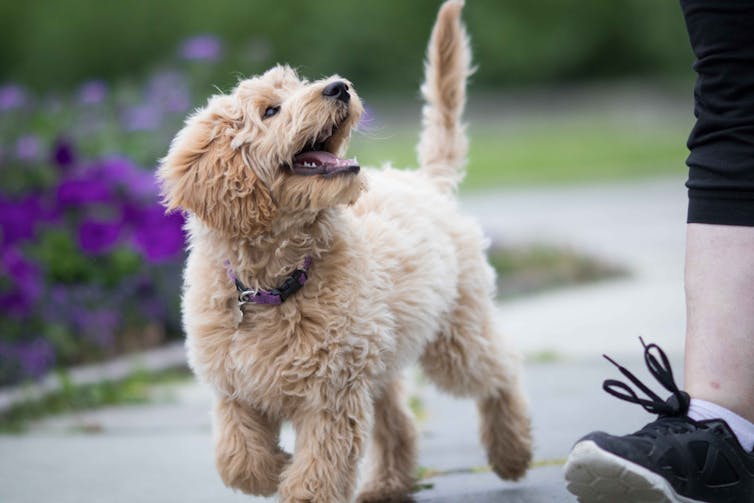New research finds Australian Labradoodles are more 'Poodle' than 'Lab'. Here's what that tells us about breeds
- Written by Frank Nicholas, Emeritus Professor of Animal Genetics, University of Sydney
It all started in the late 1980s. Wally Conron, a breeding manager for Guide Dogs Victoria, noticed that some people needing a guide dog appeared to be allergic to the shedding hairs of Labrador Retrievers.
Aware of the perception that Poodles shed little hair and so shouldn’t create such a reaction, Wally crossed a Labrador Retriever with a Standard Poodle. The result proved to be successful, and breeding “Labradoodles” took off around the world, with Wally left standing on the sidelines.
 This is Sultan, the very first Labradoodle.
Guide Dogs Victoria
This is Sultan, the very first Labradoodle.
Guide Dogs Victoria
In a new study, an international research team has documented the molecular basis of the Australian Labradoodle. Their main conclusion is that animals in the Australian Labradoodle breed registry are mostly poodle, and not a 50-50 split as might have been expected. It’s also important to mention the Australian Labradoodle is a budding breed, not yet an official one.
These results aren’t surprising to animal geneticists. They provide scientific evidence for the common understanding of how breeders choose dogs to mate for their desirable traits, such as a poodle-like coat. And over generations, this preference leads to a strong genetic predominance in the new breed.
What the research found
The researchers from USA, Pakistan and South Korea analysed genetic data from individual Australian Labradoodle dogs and a variety of other breeds, including Labrador Retrievers and Poodles of different varieties. They included dogs from the two distinct types of Labradoodles:
Labradoodles: the offspring of a Labrador and a Poodle
Australian Labradoodles: dogs resulting from generations of breeding and selection among the descendants of early crosses between Labrador Retrievers and Standard Poodles and (as it turns out) the occasional other breed.
 Australian Labradoodles often include other breeds such as Spaniels to, for example, make them smaller.
Shutterstock
Australian Labradoodles often include other breeds such as Spaniels to, for example, make them smaller.
Shutterstock
So, what did the researchers discover?
Not surprisingly, the actual offspring of a cross between a Labrador and a Poodle have an equal share of genetic material from each breed. We expect this because each pup will have one Labrador chromosome and one Poodle chromosome for each chromosome pair.
Also not surprisingly, individual dogs of the Australian Labradoodle breed have a range of proportions of Labrador and Poodle ancestry, strongly tending towards the Poodle.
Read more: Is your dog happy? Ten common misconceptions about dog behaviour
When first generation Labradoodles are bred together, their resulting descendants have a range of genetic contributions from the Labrador or Poodle grandparents.
Any pup can have 100% Labrador DNA, 50% Poodle DNA or 100% Poodle DNA at any particular gene. If a pup accidentally inherits no poodle DNA at the relevant coat genes, then it will have a Labrador coat.
 This time-honoured illustration shows how the first-generation offspring of two breeds is similar (all having exactly one-half of chromosomes from each parental breed), in contrast to the substantial variation in subsequent generations.
M. Burns and M.N. Fraser (1966) , Author provided
This time-honoured illustration shows how the first-generation offspring of two breeds is similar (all having exactly one-half of chromosomes from each parental breed), in contrast to the substantial variation in subsequent generations.
M. Burns and M.N. Fraser (1966) , Author provided
Given the main initial aim of creating Labradoodles was to make use of the perceived low-allergenic properties of Poodles, the higher proportion of Poodle ancestry in Australian Labradoodles is expected after generations of selection for a Poodle-like coat. This is the main conclusion of the paper just published.
Interestingly, the researchers make the important point that even though a Poodle-like coat is widely regarded as being lowly allergenic, there seems to have been no research study that has investigated this. This is an important knowledge-gap that needs to be filled.
The study also found other breeds have made small contributions to Australian Labradoodles, including Poodles of different size varieties. There’s even a touch of Spaniel.
Read more: 8 things we do that really confuse our dogs
This is a common occurrence. As soon as breeders decide to mix two breeds in the hope of combining some desirable traits, it makes sense to introduce other breeds if it’s thought they could make a useful contribution. For example, a Cockerpoo (Cocker Spaniel crossed with a Poodle) might have been mixed in to make the breed smaller.
What does this tell us about the concept of dog breeds?
This study reinforces the common understanding that, from a biological point of view, a breed is an amalgam of genetic variation derived from various sources. It shows Australian Labradoodles have considerable genetic diversity, most of it derived from Poodles.
 Australian Labradoodles aren’t officially recognised as a breed.
Shutterstock
Australian Labradoodles aren’t officially recognised as a breed.
Shutterstock
As a breed becomes more recognised and more formalised, the only animals that can be registered as members of that breed are the offspring of other registered members. At present, Australian Labradoodles are commonly regarded as a breed but are not, so far as we can determine, officially recognised as such by relevant national authorities.
Importantly, there are no scientific criteria for when a breed should become closed and when it should be formally recognised: these are decisions that are made solely by interested breeders and the registering authorities.
Read more: Managing mutations of a species: the evolution of dog breeding
What this means for breeders
The Australian Labradoodle Association lists 32 accredited breeders which suggests the breed is a moderately-sized population in Australia. It likely produces 150 to 300 pups per year. This is a population size comparable with many other registered dog breeds in Australia.
As in any population of most animal species, problems can arise in any breed from the mating of close relatives. The more closely related the parents, the greater is the chance valuable genetic variation will be lost from a breed, and the greater the chance of offspring having inherited diseases.
Read more: Chocolate Labradors die earlier than yellow or black, and have more disease
Two examples of problems like this are progressive retinal atrophy (a disorder that causes blindness) and degenerative myelopathy (a disorder that causes paralysis in aged dogs).
 Breeders should use scientific tools to avoid inbreeding.
Shutterstock
Breeders should use scientific tools to avoid inbreeding.
Shutterstock
Fortunately, pedigree tools are available to enable breeders to consider a wide range of possible matings. DNA tests, which are becoming increasingly available for inherited diseases, can also be very helpful.
The International Partnership for Dogs provides information on resources available for breeders to improve dog genetic health.
In any case, the new research results have provided an important, solid scientific underpinning of the common understanding of how breeds are formed. By combining the desirable aspects of both Labradors and Poodles in one breed, the Australian Labradoodle is a welcome addition to the dog-breed pantheon.
It is to be hoped breeders of Australian Labradoodles, indeed breeders of all breeds, use the available powerful scientific tools to maintain genetic variation within their breed and reduce substantially the chance of inherited diseases.
Read more: Routine and learning games: how to make sure your dog doesn't get canine cabin fever
Authors: Frank Nicholas, Emeritus Professor of Animal Genetics, University of Sydney





